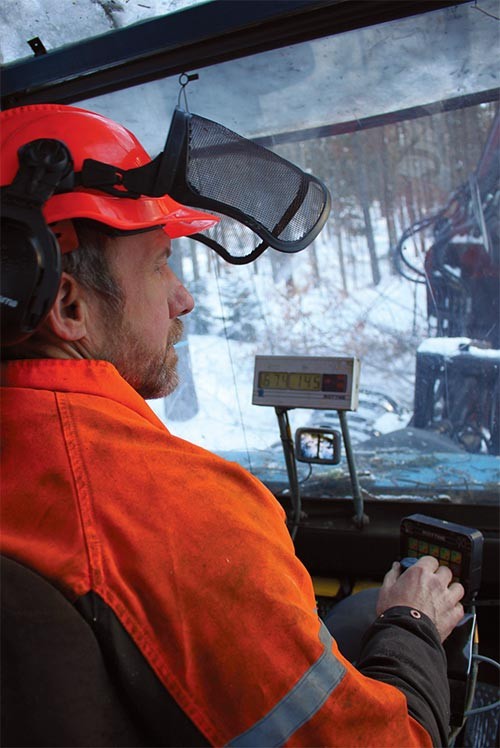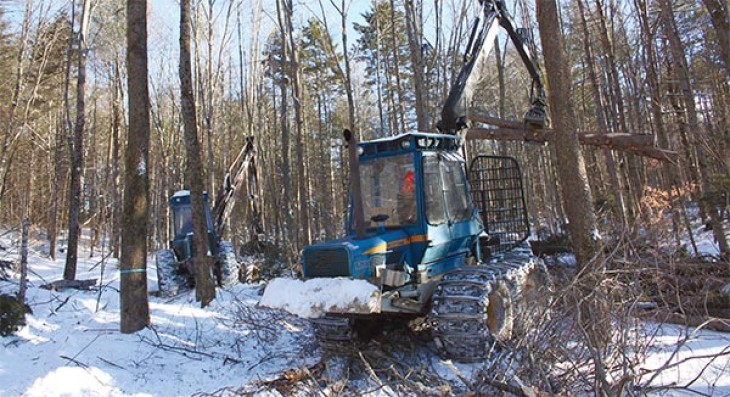
John Adler happens to be a logger, but more inherently he’s a thinker. Spend a little time with him and you quickly realize that whether he had chosen to be a banker, a builder, whatever, he would be constantly investigating ways to get the job done quicker, faster, safer, better – just as he does working in the woods.
Adler logs mostly within about a half-hour drive of his home in Chester, Vermont, but his reputation extends far beyond that radius, thanks to his work as a chainsaw safety trainer. For more than three decades, he’s been studying the safest, most efficient techniques for operating chainsaws, as well as felling and limbing trees – and then passing that information on to anyone else who runs a saw. Along with David Birdsall, he owns and operates Northeast Woodland Training, part of Game of Logging, a training curriculum developed by pioneering Swede Soren Eriksson.
A New Way of Thinking
Adler grew up in southern Maine, working on his family’s farm, as well as for the neighbors. “In the wintertime we cut wood, and in the summer we threw hay,” he recalled. “And I liked the wood more than the hay.” That led him to Paul Smith’s College, where he earned a forest technician degree in 1981. From there, Adler signed on with a sawmill in Andover, Vermont, and spent seven years working on the mill’s logging crew.
In 1983, he attended Soren’s logger safety workshop. “I had never heard of him,” said Adler. “I figured, ‘What the heck, I’ll go and see what this guy is all about.’” It was a decision that would change Adler’s approach to cutting wood and his career path.
After a morning regaling the crowd with stories of his world travels (delivered in somewhat-difficult-to-understand “Swenglish”), Eriksson gave an afternoon cutting demonstration. “I was intrigued by what he was talking about. And there were a few basic things he did differently than we were used to. So I started asking him why,” said Adler. In particular, when making his notch cut, Eriksson made the down-cut from the top before making the bottom cut. “That really caught my attention. We were all used to making the bottom cut first. It was just the way we had always done it around here.”
The two cuts need to meet precisely in order to get the full safety (steering) benefits of the hinge wood, and that’s a tricky thing to get right, even for experienced cutters. But if you make the top cut first, Eriksson explained, then you can look down through that narrow space when making the bottom cut to see exactly when the two cuts meet up. It was a simple tip – just changing the order of the cuts – but to Adler the larger concept was profound: “It opened up a whole mindset of thinking about every single move you make in the woods. Is there a better way? Is there a safer way? Is there a more efficient way? I asked myself if there were other things I was doing that didn’t make sense – things that I was doing just because I’d seen other people do it that way.”
Adler adopted other new techniques he learned from Eriksson, like square-filing rather than round-filing his chain in order to cut faster. He journeyed to watch Eriksson conduct other presentations, wanting to learn everything he could. “I started learning to use wedges more efficiently, so I was laying the wood down better for the skidder. More wood, more money… and I’m feeling safer because I’m in better control of what’s happening. I just ate all this stuff up.” The Swede took notice and realized he had a kindred spirit in Adler, someone not just taking a class mandated by an employer or insurance company but someone who really wanted to understand things so he could do a better job.
When Eriksson created the format for what would become Game of Logging, Adler was on his list of potential instructors. “Twenty years later, the rest is history,” said Adler. He has conducted hundreds and hundreds of trainings, not only around Vermont but throughout New York, New England, and in many other parts of the country.
All of that training kept Adler on the road almost constantly. In the late 1980s, he started his own logging business – Eagle Forest Improvement – but for long stretches of each year, especially during the summer, he was training more than he was logging. In the last few years, he’s scaled back and he and Birdsall have hired two additional instructors – Allan Sands and John Michalski – at Northeast Woodland Training. While he’s still on-call as an instructor, Adler said he is enjoying the flexibility that now frees up his weekends for trips to see his new grandchildren in Massachusetts. And to think of new innovations for his own logging operation.
A Different Type of Training
Adler has been using a cut-to-length approach from the time he started his company, opting to use a forwarder to carry cut logs out of the woods rather than a cable skidder to drag trees out. He was one of the few loggers in this region using a forwarder 25 years ago, but many more have followed suit since then. A few years ago, he took the approach one step further when he purchased a used Rottne harvester to cut and limb the wood. (Not surprisingly, he’s since spent a lot of time thinking about and making modifications that make the unit operate more efficiently.) So not only is Adler conducting fewer chainsaw training classes these days, he’s also using the tool less himself.
Adler believes that as mechanization becomes more the norm in the industry, logger training will have to reflect how the job has changed. “I spent 30 years on the ground logging with a chainsaw, and now transitioning to mechanized equipment, I’m spending a lot of time in the cab of that machine,” he said. Both are hard on the body, just in different ways. Working with a chainsaw requires a lot of physical exertion, which can take a toll. But running a complex piece of machinery all day can be just as taxing: combine the sedentary dangers that all those sitting at desk jobs are warned about with the stress of making difficult decisions and focusing intensely on what the machine is doing for hours on end.
Adler cites studies in Austria showing that as people running harvesters juggle visual information about the terrain and the wood being cut, operate the various controls and monitor all of the electronics in the cab, and ultimately try to optimize the value of each log, they are processing information and making decisions as quickly as fighter pilots.
Today, in addition to traditional hazards related to working in the woods, loggers need to be aware of hazards like shoulder and neck nerve damage, and stress. These problems are compounded when a mechanized logger has to occasionally grab a saw and cut the old fashioned way. “You no longer have that muscle tone and balance that you just took for granted when you were running a saw every day,” Adler said. “When you sit in that cab for weeks on end, you’re no longer physically in shape.” As more loggers become mechanized, he said he’s heard stories from foresters about loggers who aren’t fit enough to keep up on walks in the woods. “These guys are sitting in machines, and they’re getting really unhealthy and are developing long-term, really serious medical problems.”
Nutrition, cardiovascular health, stress relief – these are the types of training topics that Adler is thinking about these days. He and his wife now work with a personal trainer, and Adler has taken up biking in the summer. “That’s how I spend my time out of work,” he said. “I need to keep my body in shape.” On the job, Adler said he now looks for opportunities to take breaks and get out of the cab. If the chain on the cutting head starts slowing down, he’ll stop for a while to sharpen it. “Or maybe I’ll just take a walk in the woods,” he added. A good way to keep healthy – and a chance to do some thinking.


